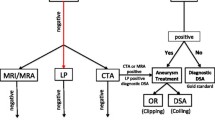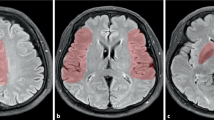Abstract
There is doubt as to whether acute haemorrhage is visible on MRI. We carried out MRI within 6 h of symptom onset on five patients with minor (low Hunt and Hess grades 1 or 2) subarachnoid haemorrhage (SAH) diagnosed by CT to search for any specific pattern. We used our standard stroke MRI protocol, including multiecho proton density (PD)- and T2-weighted images, echoplanar (EPI) diffusion- (DWI) and perfusion- (PWI) weighted imaging, and MRA. In all cases SAH was clearly visible on PD-weighted images with a short TE. In four patients it caused a low-signal rim on the T2*-weighted source images of PWI, and DWI revealed high signal in SAH. In the fifth patient SAH was perimesencephalic; susceptibility effects from the skull base made it impossible to detect SAH on EPI DWI and T2*-weighted images. Perfusion maps were normal in all cases. MRA and conventional angiography revealed an aneurysm in only one patient. Stroke MRI within 6 h of SAH thus shows a characteristic pattern.

Similar content being viewed by others
References
Jorgensen HS, Nakayama H, Raaschou HO, Olsen TS (1995) Intracerebral hemorrhage versus infarction: stroke severity, risk factors, and prognosis. Ann Neurol 38: 45–50
Powers WJ, Zivin J (1998) Magnetic resonance imaging in acute stroke: not ready for prime time. Neurology 50: 842–843
Schellinger P, Jansen O, Fiebach J, et al (2000) Feasibility and practicality of MR imaging of stroke in the management of hyperacute cerebral ischemia. AJNR 21: 1184–1189
Tomsick TA (2000) Tick tock, doc: The rapid evaluation of acute stroke to direct therapy and improve patient outcome. AJNR 21: 1177–1179
Schellinger P, Fiebach J, Jansen O, et al (2001) Stroke magnetic resonance imaging within 6 hours after onset of hyperacute cerebral ischemia. Ann Neurol 49: 460–469
Bradley WG Jr (1993) MR appearance of hemorrhage in the brain. Radiology 189: 15–26
Patel MR, Edelman RR, Warach S (1996) Detection of hyperacute primary intraparenchymal hemorrhage by magnetic resonance imaging. Stroke 27: 2321–2324
Schellinger PD, Jansen O, Fiebach JB, Hacke W, Sartor K (1999) A standardized MRI stroke protocol: comparison with CT in hyperacute intracerebral hemorrhage. Stroke 30: 765–768
Atlas S (1993) MR imaging is highly sensitive for acute subarachnoid hemorrhage... not! Radiology 186: 319–322
Perl J II, Tkach JA, Porras-Jiménez M, et al (1999) Hemorrhage detected using MR imaging in the setting of acute stroke: an in vivo model. AJNR 20: 1863–1870
Woodcock RJ, Short J, Do HM, Jensen ME, Kallmes DF (2001) Imaging of acute subarachnoid hemorrhage with a fluid-attenuated inversion recovery sequence in an animal model: comparison with non-contrast-enhanced CT. AJNR 22: 1698–1703
Noguchi K, Ogawa T, Seto H, et al (1997) Subacute and chronic subarachnoid hemorrhage: diagnosis with fluid-attenuated inversion-recovery MR imaging. Radiology 203: 257–262
Wiesmann M, Mayer T, Yousry I, Medele R, Hamann G, Brueckmann H (2002) Detection of hyperacute subarachnoidal hemorrhage of the brain by using magnetic resonance imaging. J Neurosurg 96: 684–689
Mitchell P, Wilkinson I (2001) Detection of subarachnoid haemorrhage with magnetic resonance imaging. J Neurol Neurosurg Psychiatry 70: 205–211
Wiesmann M, Mayer T, Medele R, Brückmann H (1999) Nachweis der akuten Subarachnoidalblutung. Radiologe 39: 860–865
Busch E, Beaulieu C, de Crespigny A, Moseley ME (1998) Diffusion MR imaging during acute subarachnoid hemorrhage in rats. Stroke 29: 2155–2161
Rordorf G, Koroshetz W, Copen W, et al (1999) Diffusion- and perfusion-weighted imaging in vasospasm after subarachnoid hemorrhage. Stroke 30: 599–605
Condette-Auliac S, Bracard S, Anxionnat R, et al (2001) Vasospasm after subarachnoid hemorrhage. Interest in diffusion-weighted MR imaging. Stroke 32: 1818–1824
Hadeishi H, Suzuki A, Yasui N, Hatazawa J, Shimosegawa E (2002) Diffusion-weighted magnetic resonance imaging in patients with subarachnoid hemorrhage. Neurosurgery 50: 741–748
Linfante I, Llinas RH, Caplan LR, Warach S (1999) MRI features of intracerebral hemorrhage within 2 hours from symptom onset. Stroke 30: 2263–2267
Jäger H, Mansmann U, Hausmann O, Partzsch U, Moseley I, Taylor W (2000) MRA versus digital subtraction angiography in acute subarachnoid haemorrhage: a blinded multireader study of prospectively recruited patients. Neuroradiology 42: 313–326
Fiebach J, Schellinger P, Jansen O, et al (2002) CT and diffusion-weighted MR imaging (DWI) in randomized order: DWI results in higher accuracy and lower interrater variability in the diagnosis of hyperacute ischemic stroke. Stroke 33: 2206–2210
Acknowledgments
We wish to express our gratitude to all members of the Heidelberg departments of neuroradiology, neurology, neurosurgery and the emergency room team, without whom this study could not have been achieved. The Deutsche Forschungsgemeinschaft supports our work with two research grants (SCHE 613/1-1 and FI 897/1-1).
Author information
Authors and Affiliations
Corresponding author
Rights and permissions
About this article
Cite this article
Fiebach, J.B., Schellinger, P.D., Geletneky, K. et al. MRI in acute subarachnoid haemorrhage; findings with a standardised stroke protocol. Neuroradiology 46, 44–48 (2004). https://doi.org/10.1007/s00234-003-1132-8
Received:
Accepted:
Published:
Issue Date:
DOI: https://doi.org/10.1007/s00234-003-1132-8




